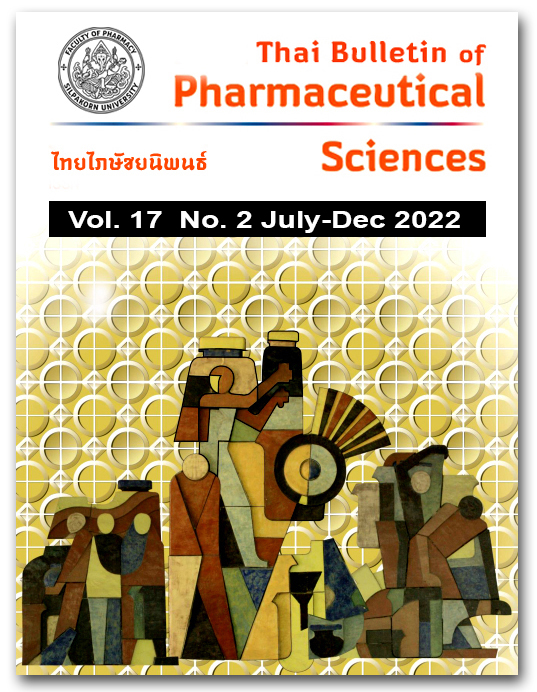FACTORS RELATING TO THE PROMOTION OF THE APPROPRIATE USE OF HERBAL PRODUCTS BY COMMUNITY PHARMACISTS
DOI:
https://doi.org/10.69598/tbps.17.2.53-68Keywords:
herbal products, community pharmacists, promoting to use of herbal productsAbstract
Community pharmacists are healthcare professionals who work closely with the community. Community pharmacists must be prepared to provide herbal product advice to support an increasing demand for herbal products. This research was a cross-sectional survey aiming to identify factors that relate to which community pharmacists promote the appropriate use of herbal products. The survey was sampled by community pharmacists. Data were collected between October 2021 and December 2021 through a questionnaire sent out by mail. Descriptive statistics and Chi-square tests were used for data analysis. The subjects returned 419 questionnaires. Most respondents were female (68.3%), with a mean age of 39.74 + 9.70 years. Most respondents had achieved the highest level of education (52.0%), that is a Bachelor degree (5-year pharmacy program). Respondents had an average of 10.84 + 8.15 years of work experience in a drugstore. Most respondents (75.7%) had some experience using herbal products to treat illnesses. Statistically significant factors that related to which community pharmacists promoted the appropriate use herbal product were gender (p-value < 0.001); the experience of community pharmacists in herbal product use for treatment (p-value = 0.007); herbal product knowledge on indication and direction (p-value = 0.026); knowledge of contraindication of herbal products (p-value < 0.001); consumer retrieval of herbal products (p-value = 0.023); and hearing or seeing advertisements for herbal products by other community pharmacists (p-value = 0.011). Therefore, educating and and encouraging community pharmacists to use herbal products to take care of their own health has an effect on them in encouraging other people to use herbal products.
References
Kasikorn Research Center. Herbal market [Internet]. 2019 [cited 2021 Jul 10]; Available from: https://www.kasikornbank.com/th/business/sme/KSMEKnowledge/article/KSMEAnalysis/Documents/Herb_Market.pdf (in Thai)
Ministry of Public Health. National master plan on the development of Thai herbs issue 1 2017-2021. Nonthaburi: Department of Thai Traditional and Alternative Medicine; 2016. (in Thai)
Pharmacy Council Board. Regulations of the pharmacy council on restrictions and conditions for practicing pharmaceutical professions 2018 [Internet]. 2018 [cited 2021 Jul 10]; Available from: https://www.pharmacycouncil.org/index.php?option=content_detail&view=detail&itemid=1316&catid=36 (in Thai)
Kidpun P. Principles of health product classification and guidelines of borderline products in Thailand and international. Thai Food Drug J. 2019;27(1):1-7. (in Thai)
“Herbal product act 2019.” The government gazette volume 136, special part 56 kor (30 April 2019): 121-164. (in Thai)
Pratumchat T, Kessomboon P. Prescribing herbal medicine for patients by health care officers at Tambon health promoting hospitals in Nongbualamphu province [Internet]. 2015 [cited 2022 Jan 10]; Available from: https://gsbooks.gs.kku.ac.th/58/the34th/pdf/MMP46.pdf (in Thai)
Itharat A, Singchongcha P, Singphibulporn N, Rattanasuwan P, Khammi S. Knowledge, attitude, readiness, and traditional medicine used of medicinal plants specified in the fundamental primary health care project of medical personnel in governmental hospitals in Sounthern Thailand [Internet]. 1996 [cited 2020 Jan 10]; Available from: https://kb.psu.ac.th/psukb/handle/2553/5090 (in Thai)
Petchsong J. Factors affecting herbal medicine prescribing of physicians in community hospitals [Dissertation]. Nakhon Pathom: Mahidol University; 2001. (in Thai)
Rathachatranon W. Determining an appropriate sample size for social science research: The myth of using Taro Yamane and Krejcie & Morgan method. KUPSRJ 2019;6(1):27-58. (in Thai)
Songsirisuk N, Upakdee N. Survey of community pharmacist’s professional activities in Thailand. Thai J Pharm Prac. 2017;9(2):307-320. (in Thai)
Sriwong BT, Pongputthangkoon P, Wisetwitsakul S, Numkiatsakul K, Phunyammalee M. Expectation of community pharmacists towards working in independent drugstore. Thai Bull Pharm Sci. 2019;14(2):31-45. (in Thai)
Chaimay B. Sample size determination in descriptive study in public health. Inth Thaksin J. 2013;16(2):9-18. (in Thai)
Vollakitkasemskul S. Research methods in behavioral sciences and social sciences. Udonthani: Aksornsilp printing; 2011. (in Thai)
Pacharavanich N, Boontha N, Wangmaneerat A. The study of opinions and experience of physician on prescribing herbal medicine in Ubon Ratchathani Province [Internet]. 2004 [cited 2020 Sep 15]; Available from: http://www.esanpedia.oar.ubu.ac.th/eresearch/sites/default/files/Natee_Patcharawanich.pdf (in Thai)
Khaesuntia P, Kanjanarach T. Problems and suggestions for substituting modern medications with herbal medicines in public hospital: A pilot study from the perspective of health professionals at community hospital in the Northeast. Thai Bull Pharm Sci. 2021;13(4):837-46. (in Thai)
Meksawasdichai C. Evaluation of policies promoting the use of herbal medicine in hospital. In the Ministry of Public health in Saraburi province in 2017. J Thai Trad Alt Med 2019;17(3):516-526. (in Thai)
Sanalad R, Kittiboonyakhun P, Nualkaew S. Effects of the intervention for promoting the prescribing of herbal medicines in the national lists of essential medicines in community hospital at Mahasarakham province. Thai Bull Pharm Sci. 2021;13(4):933-43. (in Thai)
Downloads
Published
How to Cite
Issue
Section
License
All articles published and information contained in this journal such as text, graphics, logos and images is copyrighted by and proprietary to the Thai Bulletin of Pharmaceutical Sciences, and may not be reproduced in whole or in part by persons, organizations, or corporations other than the Thai Bulletin of Pharmaceutical Sciences and the authors without prior written permission.



